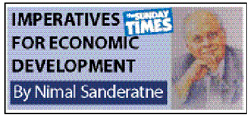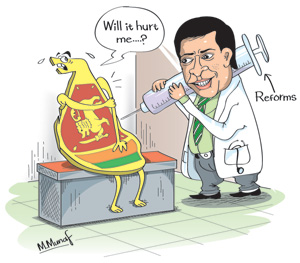Columns
Macroeconomic compulsions and structural challenges to generate economic growth
View(s):There is no longer a possibility of continuing foreign funded growth strategies or doing business as usual to achieve high economic growth. Fundamental flaws in the economy require to be addressed to benefit from the propitious global conditions that could enable Sri Lanka’s economic growth.
 The reduction of the fiscal deficit and appropriate monetary, fiscal and exchange rate policies are essential in the short term. And in the medium term, structural reforms are preconditions to achieving high economic growth. There should also be a shift from an entitlement culture to one based on productivity, efficiency and competitiveness.
The reduction of the fiscal deficit and appropriate monetary, fiscal and exchange rate policies are essential in the short term. And in the medium term, structural reforms are preconditions to achieving high economic growth. There should also be a shift from an entitlement culture to one based on productivity, efficiency and competitiveness.
Dr Indrajit Coomaraswamy presented these propositions in his lecture “Towards a new growth model: macroeconomic compulsions and structural challenges” at the seminar organised by the Gamani Corea Foundation and the Marga Institute at the BMICH on October 15th. His comprehensive and cogent analysis pointed out that the full potential of the economy could only be realised through fiscal consolidation followed by structural reforms.
High priority
Dr. Coomaraswamy stressed the need for clarity in policies and said that the PM’s statement in early November and the Budget Speech on November 20th should set out clear policy directions, advance fiscal consolidation and introduce structural reforms. A well thought out package of consistent and predictable policies supported by good governance and effective implementation, he pointed out, was a high priority. New independent commissions should be in place quickly and function effectively for good governance.
 Reforms
Reforms
Structural reforms, he admitted, were painful during the transition, but if the needed adjustments were postponed, it would be far more painful and disruptive. Public awareness and building a social and political consensus on the necessity for politically difficult reform was essential.
Macroeconomic compulsions
Bringing down the public debt, foreign debt and fiscal deficit are short term imperatives for economic stabilisation and growth. Dr. Coomaraswamy pointed out that debt dynamics are in amber light territory with the Debt/GDP ratio at 74 per cent without taking into account contingent liabilities. This was excessive as the median for countries with same rating was 35 per cent. More than 20 per cent of earnings from exports of goods and services were needed for the servicing of the external debt.
Since the total debt-servicing absorbs 95 per cent of government revenue, almost all other government expenditure has to be financed out of borrowing. In a fiscal situation where government revenue is spent entirely on debt servicing, investment would necessarily have to be by the private sector. The headroom for further commercial borrowing was limited by the decline in risk appetite for emerging market investments with economic uncertainty in China and the possibility of US Federal Reserve Bank’s interest rate takeoff.
Growth strategies
While admitting that successful development outcomes are possible through a whole spectrum of statist or private sector approaches, Sri Lanka’s fiscal deficit and high debt profile does not provide scope for state led development. Therefore, Dr. Coomaraswamy argued that private investment has to be “the locomotive of growth and development”.
The new growth model must be driven by export led growth and higher levels of foreign direct investment. The country’s growth must be export based as the domestic market of 21 million will not sustain an 8 per cent growth for 10-15 years. He pointed out that all successful East and South East Asian countries adopted an export-led growth model.
Export performance
In Sri Lanka, exports of goods and services have declined from 32 per cent of GDP in 2000 to 20 per cent today and the economy has become much more closed over the last 10 years, favouring the domestic market rather than the export market. “The economy is as closed as it was in 1970″. In contrast, Malaysia, Thailand and Vietnam’s exports exceed 70 per cent of their GDP.
Export growth can be achieved by plugging into regional/global supply chains and to sectors such as information communication technology (ICT), business process outsourcing (BPO), knowledge process outsourcing (KPO), shipping, aviation and tourism.
Why FDI?
To achieve an 8 per cent growth, an investment of 34 per cent of GDP is required. Currently 29 per cent of GDP with national savings of 25 per cent of GDP) is invested. Therefore we need more non-debt creating foreign inflows to fill the savings/investment gap.
Foreign direct investment (FDI) also brings technology, markets, branding and know-how. However FDI in Sri Lanka is less than US$ 1 billion even five years after the conflict ended, whereas Malaysia and Thailand attract three or four times this as a per centage of GDP. Sri Lanka needs to attract US$ 3.5 – $4 billion a year. For this the investment climate has to be improved and economic policies have to be predictable and consistent.
Structural reform
Dr. Coomaraswamy emphasised that structural reforms were essential for achieving the country’s growth potential. Past experience amply demonstrates that stabilization without structural reform has led to subdued growth. Second generation reforms in factor and product markets are needed. Trade facilitation is also important given the trade-investment nexus.
Balance
Although Dr. Coomaraswamy’s model was geared to economic growth that is a prerequisite for societal development, he emphasised that overall there should be a good balance between social development and wealth creation and a shift from entitlement culture to a focus on productivity and competitiveness.
Discussants
Dr Dushni Weerakoon, Deputy Director of the Institute of Policy Studies (IPS) pointed out that there were three phases of reforms in the past that saved the economy from stagnation. The country had arrived at another juncture when a new wave of reforms is necessary for economic growth. However reforms have losers and the ingredients for reform were not present.
Professor Sirimal Abeyratne of the University of Colombo had no disagreement with the Coomaraswamy thesis and pointed out that the debt situation was particularly serious as it was 700 per cent of revenue. Also the correct figure of FDI was not the official US$ 1.3 billion, but only US$ 0.8 billion when loans are removed. As there is a close nexus between trade links and investment trade facilitation was vital to attract FDI.
Concluding reflection
The consensus among economists is that the immediate task is to correct the fundamental macroeconomic weaknesses of a large fiscal deficit, reduce the public and foreign debt and achieve a more manageable trade deficit and usher in a new wave of economic reforms to harness the economy’s full potential. Will the November 20th budget have a policy framework to cope with these economic challenges?


Leave a Reply
Post Comment